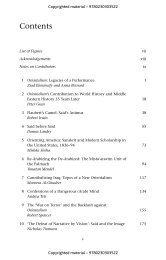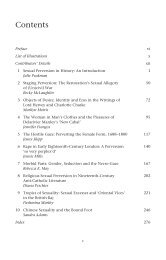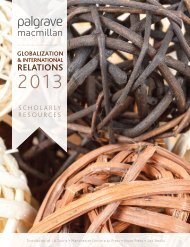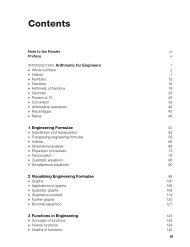Chapter 6 - Bibliography - Palgrave
Chapter 6 - Bibliography - Palgrave
Chapter 6 - Bibliography - Palgrave
You also want an ePaper? Increase the reach of your titles
YUMPU automatically turns print PDFs into web optimized ePapers that Google loves.
<strong>Chapter</strong> 6<br />
<strong>Bibliography</strong><br />
Adler, N. and Graham, J.L. (1989) ‘Cross-cultural interaction: The international comparison fallacy?’, Journal of<br />
International Business Studies, 515–37.<br />
Alba, N. (1978) ‘Ethnic networks and tolerant attitude’, Public Opinion Quarterly, 42: 1–16.<br />
Aldrich, H. (1982) ‘The origins and persistence of social networks’, in Marsden, P. and Lin, N. (eds) Social Structure and<br />
Network Analysis, Beverly Hills, CA.: Sage.<br />
Anderson, R.J. and Carlos, M.L. (1976) ‘What is social network theory?’ in Burns, T. and Buckley, W. (eds) Power and<br />
Control, London: Sage.<br />
Applegate, J.L. and Sypher, H.E. (1988) ‘A constructivist theory of communication and culture’ in Kim, Y.Y. and Gudykunst,<br />
W.B. (eds) Theories in Intercultural Communication, Newbury Park, CA: Sage.<br />
Asante, M.K., Gudykunst, W.B. and Newmark, E. (1989) Handbook of International and Intercultural Communication,<br />
Newbury Park, CA: Sage.<br />
Baesler, E.J. and Burgoon, J.K. (1994) ‘The temporal effects of story and statistical evidence on belief change’,<br />
Communication Research, 21(5): 582–602.<br />
Balle, L. and Gottschalk, A. (1994) ‘Negotiating with other Europeans’, Management Extra, London: The Association of<br />
MBAs.<br />
Ball-Rokeach, S.J. (1973) ‘From pervasive ambiguity to a definition of the situation’, Sociometry, 36: 378–89.<br />
Baxter, L.A. and Goldsmith, D. (1990) ‘Cultural terms for communication events among some American high school adolescents’,<br />
Western Journal of Speech Communication, 54(3): 377–94.<br />
Beebe, L.M. and Giles, H. (1984) ‘Speech accommodation theories: A discussion in terms of second-language acquisition’,<br />
International Journal of the Sociology of Language, 46: 5–32.<br />
Belay, Getinet (1993). ‘Toward a paradigm shift for intercultural and international communication: new research directions’,<br />
Communication Yearbook, 16: 437–57.<br />
Berger, C.R. (1987) ‘Communicating under uncertainty’, in Roloff, M.E. and Miller, G.R. (eds) Interpersonal Processes,<br />
Newbury Park, CA: Sage.<br />
Berger, C.R. and Zelditch, M. (1985) Status, Rewards and Influence, San Francisco: Jossey-Bass.<br />
Bernstein, B. (1971) Class, Codes and Control, St Albans: Paladin.<br />
Berry, J.W., Kim, U., Minde, T. and Mok, D.I. (1988) ‘Comparative studies of acculturative stress’, International Migration<br />
Revue, XXI, 491–512.<br />
Birdwhistell, R. (1970) Kinesics and Context, Philadelphia: University of Pennsylvania Press.<br />
Black, J.S., Gregerson, H.B. and Mendenhall, M.E. (1992) Global Assignments, San Francisco: Jossey-Bass.<br />
Blau, P. (1982) ‘Structural sociology and network analysis’ in Marsden, P. and Lin, N. (eds) Social Structure and Network<br />
Analysis, Beverly Hills, CA: Sage.<br />
Blommaert, J. and Verschueren, J. (eds) (1991) The Pragmatics of International and Intercultural Communication,<br />
Amsterdam: John Benjamins.<br />
Blum, T.C., Fields, D.L. and Goodman, J.S. (1994) ‘Organization-level determinants of women in management’, Academy<br />
of Management Journal, 37(2): 241–68.<br />
Boissevain, J. (1974) Friends of Friends: Networks, Manipulators and Coalitions, Oxford: Blackwell.<br />
Boje, D.M. (1991) ‘The storytelling organisation: A study of story performance in an office-supply firm’, Administrative<br />
Science Quarterly, 36(1): 106–26.<br />
Brown, R. and Gilmour, A. (1960) ‘The pronouns of power and solidarity’, in Sebeok, T. (ed.) Style in Language,<br />
Cambridge, MA: MIT Press.<br />
Brown, P. and Levinson, S. (1978) ‘Universals in language usage: politeness phenomena’, in Goody, E.N. (ed.) Questions<br />
and Politeness: Strategies in Social Interaction, (pp. 56–289) Cambridge: CUP.<br />
Buller, P.R. (1991) ‘Networking: the overlooked benefit of training’, Training and Development Journal, 45(7): 41–4.<br />
Burgoon, J.K. and Le Poire, B.A. (1993) ‘Effects of communication expectancies, actual communication and expectancy<br />
disconfirmation on evaluations of communicators and their communication behavior’, Human Communication Research,<br />
20(1): 67–96.<br />
Burgoon, J.K., Stacks, D.W. and Woodall, W.G. (1979). ‘A communicative model of violations of distancing expectations’,<br />
Western Journal of Speech Communication, 43(2): 153–67.<br />
Burgoon, J K., Dillman, L. and Stern, L.A. (1993) ‘Adaptation in dyadic interaction: defining and operationalizing patterns<br />
of reciprocity and compensation’, Communication Theory, 3(4): 295–316.<br />
125
COMMUNICATING ACROSS CULTURES – TEACHERS’ MANUAL<br />
Burgoon, J.K., Buller, D.B., Ebesu, A.S. and Rockwell, P. (1994) ‘Interpersonal deception: accuracy in deception detection’,<br />
Communication Monographs, 61(4): 303–25.<br />
Burgoon, M., Birk, T.S. and Hall, J.R. (1991). ‘Compliance and satisfaction with physician–patient communication: an<br />
expectancy theory interpretation of gender differences’, Human Communication Research, 18(2): 177–208.<br />
Camron, C., Cranmer, D.F., Alvino, E., Garrott, J.R. and Smith, P. (1995) ‘A selective annotated bibliography of works on<br />
the topic of language, culture and world view’, International Journal of Intercultural Relations, 19(2): 343–62.<br />
Casmir, F.L. (1978) ‘A multicultural perspective of human communication’ in Casmir F.L. (ed.), Intercultural and<br />
International Communication (pp. 241–57), Washington, DC: University Press of America.<br />
Casmir, F.L. (1993) ‘Third-culture building: a paradigm shift for international and intercultural communication’,<br />
Communication Yearbook, 16: 407–28.<br />
Casmir, F.L. and Asuncion-Lande, N.C. (1989) ‘Intercultural communication revisited: conceptualization, paradigm building<br />
and methodological approaches’ in Anderson, J.A. (ed.) Communication Yearbook, 12: 278–309.<br />
Chandler, T.A., Shama, D.D., Wolf, F.M. and Planchard, S.K. (1981) ‘Multiattributional causality for social affiliation across<br />
five cross-national samples’, Journal of Psychology, 107: 219–29.<br />
Choi, J. and Tamborini, R. (1988) ‘Communication–acculturation and the cultivation process: a comparative study between<br />
two Korean communities in the US’, Howard Journal of Communications, 1(1): 57–74.<br />
Cohen, L., van den Bout, J., Kramer, W. and van Vliet, T. (1986) ‘A Dutch attributional style questionnaire: psychometric<br />
properties and findings of some Dutch–American differences’, Cognitive Therapy and Research, 10: 665–9.<br />
Collier, M.J. and Thomas, M. (1988) ‘Cultural identity: an interpretive perspective’ in Kim, Y.Y. and Gudykunst, W.B.,<br />
Theories in Intercultural Communication, Newbury Park, CA: Sage.<br />
Conrad, C. (1989) ‘Strategic organisational communication: cultures, situations and adaptation’, Technical Communication,<br />
36(4): 393–4.<br />
Cook, K. (1982) ‘Network structures from an exchange perspective’ in Marsden, P. and Lin, N. (eds) Social Structure and<br />
Network Analysis, Beverly Hills, CA: Sage.<br />
Cox, T. (1993) Cultural Diversity in Organisations: Theory, Research and Practice, San Francisco, CA: Berrett-Koehler.<br />
Cronen, V.E., Chin,V. and Pearce, W.B. (1988) ‘Co-ordinated management of meaning’ in Kim, Y.Y. and Gudykunst, W.B.<br />
Theories in Intercultural Communication, Newbury Park, CA: Sage.<br />
De Verthelyi, R.F. (1995) ‘International student’s spouses: invisible sojourners in the culture shock literature’, International<br />
Journal of Intercultural Relations, 19: 387–411.<br />
Fagenson, E.A. (ed.) (1993) ‘Women in management’, Vol. 4, Newbury Park, CA: Sage.<br />
Fantini, A.E. (1992) ‘Exploring language, culture and worldview’, Interspectives: A Journal on Transcultural and Peace<br />
Education, 2: 13–16.<br />
Featherstone, M. (ed.) (1988) Post-modernism, London: Sage.<br />
Fiedler, M. and Triandis, H. (1971) ‘The culture assimilator: an approach to cross-cultural training’, Journal of Applied<br />
Psychology, 55: 95–102.<br />
Friesen, J.W. (1985) When Cultures Clash: Case Studies in Multiculturalism, Calgary, Canada: Detselig.<br />
Forgas, J.P. (1976) ‘The perception of social episodes: categorical and dimensional reps in two different social milieus’,<br />
Journal of Personality and Social Psychology, 33: 199–209.<br />
Forgas, J.P. (1978) ‘Social episodes and social structure in an academic setting: The social environment of an intact group’,<br />
Journal of Experimental Social Psychology, 4: 434–48.<br />
Forgas, J.P. (1983) ‘Social skills and episode perception’, British Journal of Clinical Psychology, 22: 26–41.<br />
Fry, P.S. and Ghosh, R. (1980) ‘Attributions of success and failure: comparison of cutural differences between Asian and<br />
Caucasian children’ Journal of Cross-Cultural Psychology, 11: 343–63.<br />
Gao, G. and Gudykunst, W.B. (1990) ‘Uncertainty, anxiety and adaptation’, International Journal of Intercultural Relations,<br />
14: 301–17.<br />
Gardner III, W.L., Van Eck Peluchette, J. and Clinebell, S.K. (1994) ‘Valuing women in management: an impression<br />
management perspective of gender diversity’, Management Communication Quarterly, 8(2): 115–64.<br />
Giles, H. and Byrne, J.L. (1982) ‘An intergroup approach to second language acquisition’, Journal of Multilingual and<br />
Multicultural Development, 3: 17–40.<br />
Gochenour, T. (ed.) (1993) Beyond Experience: The Experiential Approach to Cross-Cultural Education (Rev.), Yarmouth<br />
ME: Intercultural Press.<br />
Gordon, M.M. (1964) Assimilation in American Life: The Role of Race, Religion and National Origin, New York: Oxford<br />
University Press.<br />
Graham, M.A. (1983) ‘Acculturative stress among Polynesian, Asian and American students on the Brigham Young<br />
University-Hawaii campus’, International Journal of Intercultural Relations, 7: 79–103.<br />
Grice, H.P. (1975) ‘Logic and conversation’ in Syntax and Semantics, Vol. 3, Cole, P. and Morgan, J. (eds), NY: Academic<br />
Press.<br />
Gudykunst, W.B. (1983) ‘Similarities and differences in perceptions of initial intracultural and intercultural encounters: an<br />
exploratory investigation’, The Southern Speech Communication Journal, 49: 49–65.<br />
Gudykunst, W.B. (1986) ‘Ethnicity, types of relationship and intraethnic uncertainty reduction’ in Kim, Y.Y. (ed.) Interethnic<br />
Communication: Current Research (pp. 201–24), Beverly Hills, CA: Sage.<br />
126
BIBLIOGRAPHY<br />
Gudykunst, W.B. (1988) ‘Uncertainty and anxiety’ in Kim, Y.Y. and Gudykunst, W.B., Theories in Intercultural<br />
Communication, Newbury Park, CA: Sage.<br />
Gudykunst, W.B. and Halsall, S.J. (1980) ‘The application of a theory of contraculture to intercultural communication:<br />
searching for isomorphic processes’, Communication Yearbook 4: 427–36.<br />
Gudykunst, W.B. and Hammer, M.R. (1987) ‘Strangers and hosts: an uncertainty reduction based theory of intercultural<br />
adaptation’ in Kim, Y.Y. and Gudykunst, W.B. (eds) Cross-Cultural Adaptation: Current Approaches, Newbury Park,<br />
CA: Sage.<br />
Gudykunst, W.B. and Hammer, M.R. (1988) ‘Strangers and hosts: an uncertainty reduction based theory of intercultural<br />
adaptation’ in Kim, Y.Y. and Gudykunst, W.B. (eds) Cross-Cultural Adaptation: Current Approaches (pp. 106–39),<br />
Newbury Park, CA: Sage.<br />
Gudykunst, W.B. and Hammer, M.R. (1988) ‘The influence of social identity and intimacy of interethnic relationships on<br />
uncertainty reduction processes’, Human Communication Research, 14: 569–601.<br />
Gudykunst, W.B. and Kim, Y.Y. (1984) Communicating with Strangers, Reading, MA: Addison-Wesley.<br />
Gudykunst, W.B. and Kim, Y.Y. (1992) Communicating with Strangers: An Approach To Intercultural Communication (2nd<br />
edn), New York: McGraw-Hill.<br />
Gudykunst, W.B. and Lim, T.S. (1986) ‘A perspective for the study of intergroup communication’ in Gudykunst, W.B. (ed.)<br />
Intergroup Communication, London: Edward Arnold.<br />
Gudykunst, W.B. and Nishida, T. (1994) Bridging Japanese/North American Differences, Thousand Oaks, CA: Sage.<br />
Gudykunst, W.B., Hua, E. and Gray, A.J. (1987) ‘Cultural dissimilarities and uncertainty reduction processes’ in<br />
McLaughlin, M. (ed.) Communication Yearbook 10 (pp. 456–69) Beverly Hills, CA: Sage.<br />
Gudykunst, W.B., Nishida, T. and Chua, W. (1986) ‘Uncertainty reduction in Japanese-North American dyads’,<br />
Communication Research Reports, 3: 39–46.<br />
Gudykunst, W.B. and Ting-Toomey, S. with Chua, E. (1988) Culture and Interpersonal Communication, Newbury Park, CA:<br />
Sage.<br />
Gudykunst, W.B., Wiseman, R. and Hammer, M. (1977) ‘Determinants of a sojourner’s attitudinal satisfaction: a path model’<br />
in Rubin, B. (ed.), Communication Yearbook 1: 415–25.<br />
Gudykunst, W.B., Yang, S.M. and Nishida, T. (1985) ‘A cross-cultural test of uncertainty reduction theory: comparisons of<br />
acquaintance, friend and dating relationships in Japan, Korea and the US’, Human Communication Research, 11: 407–55.<br />
Gudykunst, W.B., Nishida, T., Koike, H. and Shiino, N. (1986) ‘The influence of language on uncertainty reduction: an<br />
exploratory study of Japanese–Japanese and Japanese–North American interactions’ in McLaughlin, M. (ed.),<br />
Communication Yearbook 10: 456–69, Beverly Hills, CA: Sage.<br />
Hall, E.T. (1976) Beyond Culture, Garden City, NY: Anchor.<br />
Hall, E.T. (1979) ‘Cultural models in transcultural communication’ in Wolfgang, A. (ed.) Non-verbal Behaviour:<br />
Applications and Cultural Implications, New York: Academic Books.<br />
Haslett, B. (1989) ‘Communication and language acquisition within a cultural context’ in Ting-Toomey, S. and Korzenny, F.<br />
(eds) Language, Communication and Culture: Current Directions, Newbury Park, CA: Sage.<br />
Haynes, D. (1972) ‘Models of the interaction of language and social life’ in Gumperz, J. and Haynes, D. (eds) Directions of<br />
Sociolinguistics, New York: Holt, Rinehart and Winston.<br />
Horvath, C.W. (1995) ‘Biological origins of communicator style’, Communication Quarterly, 43: 394–407.<br />
Jacobs, S. (1985) ‘Language’ in Knapp, M.L. and Miller, G.R. (eds) Handbook of Interpersonal Communication, Beverly<br />
Hills, CA: Sage.<br />
Jehn, K. and Weldon, E. (1992) ‘A comparative study of managerial attitudes toward conflict in the United States and the<br />
People’s Republic of China: issues of theory and measurement’, Paper presented at the Academy of Management, Las<br />
Vegas, NV.<br />
Kashima, Y. and Triandis, H.C. (1986) ‘The self-serving bias in attributions as a coping strategy: a cross-cultural study’,<br />
Journal of Cross-Cultural Psychology, 17(1): 83–97.<br />
Katriel, T. (1989) ‘From “context” to “contexts” in intercultural communication research’ in Ting-Toomey, S. and Korzenny,<br />
F. Language, Communication and Culture: Current Directions, Newbury Park, CA: Sage.<br />
Kelman, H. and Cohen, S. (1986) ‘Resolution of international conflict: an interaction approach’ in Worchel, S. and Austin,<br />
W. (eds), Psychology of Intergroup Relations (pp. 140–56) Chicago: Nelson-Hall.<br />
Kim, J.K. (1980) ‘Explaining acculturation in a communication framework: an empirical test’, Communication<br />
Monographs, 47(3): 155–79.<br />
Kim, M.-S., Hunter, J.E., Miyahara, A., Horvath, A., Bresnahan, M. and Yoon, H. (1996) ‘Individual- vs culture-level dimensions<br />
of individualism and collectivism: effects on preferred conversational styles’, Communication Monographs, 63:<br />
29–49.<br />
Kim, Y.Y. (1977) ‘Communication patterns of foreign immigrants in the process of acculturation’, Human Communication<br />
Research, 4(1): 66–77.<br />
Kim, Y.Y. (1979) ‘Toward an interactive theory of communication-acculturation’, Communication Yearbook, 3: 435–53.<br />
Kim, Y.Y. (1986) ‘Understanding the social context of intergroup communication: a personal network theory’ in Gudykunst,<br />
W.B. (ed.) Intergroup Communication (pp. 86–95), London: Edward Arnold.<br />
Kim, Y.Y. (1987) ‘Facilitating immigrant adaptation: the role of communication’ in Albrecht, T. and Adelman, M. (eds),<br />
Communicating Social Support (pp. 192–211), Newbury Park, CA: Sage.<br />
127
COMMUNICATING ACROSS CULTURES – TEACHERS’ MANUAL<br />
Kim, Y.Y. (1988) Communication and Cross-cultural Adaptation: An Integrative Theory, Philadelphia: Multi-Lingual<br />
Matters.<br />
Kim, Y.Y. (1988) ‘On theorizing intercultural communication’ in Kim, Y.Y. and Gudykunst, W.B. Theories in Intercultural<br />
Communication, Newbury Park, CA: Sage.<br />
Kim, Y.Y. (1989) ‘Interethnic conflict: an interdisciplinary review’ in Gittler, J. (ed.), The Annual Review of Conflict<br />
Knowledge and Conflict Resolution, Vol. 1 (pp. 101–25), New York: Garland.<br />
Kim, Y.Y. (1991) ‘Intercultural personhood: an integration of Eastern and Western perspectives’ in Samovar, L. and Porter,<br />
R. (eds), Intercultural Communication: A Reader (6th edn), pp. 401–10, Belmont CA: Wadsworth.<br />
Kim, Y.Y. (1991) ‘Intercultural communication competence: a systems-theoretic view’ in Ting-Toomey, S. and Korzenny, F.<br />
(eds), International and Intercultural Communication Annual (pp. 259–75), Newbury Park, CA: Sage.<br />
Kim, Y.Y. (1994) ‘Interethnic communication: the context and the behavior’, Communication Yearbook, 17: 511–38.<br />
Kim, Y.Y. and Rubin, B. (1988) ‘Intercultural transformation: a systems theory’ in Kim, Y.Y. and. Gudykunst, W.B. (eds),<br />
Theories in Intercultural Communication (pp. 299–321), Newbury Park, CA: Sage.<br />
Kincaid, D.L. (1987) ‘The convergence theory of communication, self-organization and cultural evolution’ in Kincaid, D.<br />
(ed.), Communication Theory: Eastern and Western Perspectives, NY: Academic Press.<br />
Kincaid, D.L., Yum, J.O. and Woelfel, J. (1983) ‘The cultural convergence of Korean immigrants in Hawaii: an empirical<br />
test of a mathematical theory’, Quality and Quantity, 18: 59–78.<br />
Kline, S.L. and Ceropski, J.M. (1984) ‘Person-centred communication in medical practice’ in Wood, J.T. and Phillips, G.M.<br />
(eds) Human Decision-making, Carbondale: South Illinois University Press (pp. 120–41).<br />
Kluckhohn, F. and Strodtbeck, F. (1961) Variations in Value Orientations, New York: Row, Peterson.<br />
Kochman, T. (1983) Black and White: Styles in Conflict, Urbana: University of Illinois Press.<br />
Kramarae, C., Schulz, M. and O’Barr, W.M. (1984) ‘Toward an understanding of language and power’ in Kramarae, C.,<br />
Schulz, M. and O’Barr, W.M. (eds), Language and Power (pp. 9–22), Beverly Hills, CA: Sage.<br />
Kroeber, A.L. and Kluckhohn, C. (1952) Culture: A Critical Review of Concepts and Definitions, Cambridge, MA: Harvard<br />
University Press.<br />
Langer, E. (1989) Mindfulness, Reading: Addison-Wesley.<br />
Lenneberg, E. (1967) The Biological Foundations of Language, New York: John Wiley.<br />
Leodolter, R. and Leodolter, M. (1976) ‘Sociolinguistic considerations on psychosocial socialisation’ in McCormack, W. and<br />
Wurm, S. (eds), Language and Man, The Hague: Mouton.<br />
Le Poire, B.A. and Burgoon, J.K. (1994) ‘Two contrasting explanations of involvement violations: expectancy violations<br />
theory versus discrepancy arousal theory’, Human Communication Research, 20(4): 560–91.<br />
Le Poire, B.A., Burgoon, J.K. and Parrott, R. (1992) ‘Status and privacy restoring communication in the workplace’, Journal<br />
of Applied Communication, 20(4): 419–36.<br />
Levine, R. (1984) ‘Properties of culture: an ethnographic view’ in Schweder, L. and Levine, R. (eds) Cultural Theory,<br />
Cambridge: CUP.<br />
Lum, C.M.K. (1991) ‘Communication and cultural insularity: the Chinese immigrant experience’, Critical Studies in Mass<br />
Communication, 8(1 March): 91–101.<br />
Manusov, V. and Radha, H. (1993) ‘Communicative outcomes of stereotype-based expectancies: an observational study of<br />
cross-cultural dyads’, Communication Quarterly, 41(3): 338–54.<br />
Markus, R.H. and Kitayama, S. (1991) ‘Culture and the self: implications for cognition, emotion and motivation’,<br />
Psychological Review, 98: 224–53.<br />
Markus, R.H. and Kitayama, S. (1994) ‘A collective fear of the collective: implications for selves and theories of selves’,<br />
Personality and Social Psychology Bulletin, 20(5): 568–79.<br />
Martin, J.N., Bradford, L. and Rohrlich, B. (1995) ‘Comparing pre-departure expectations and post-sojourn reports: a longitudinal<br />
study of US students abroad’, International Journal of Intercultural Relations, 19: 87–110.<br />
McCann, L.D., Hecht, M.L. and Ribeau, S. (1986) ‘Communication apprehension and second language acquisition among<br />
Vietnamese and Mexican immigrants: a test of the affective filter hypothesis’, Communication Research Reports, 3(1):<br />
33–8.<br />
McClelland, V. (1987) ‘Communication: mixed signals breed mistrust’, Personnel Journal, 66(3): 24–9.<br />
Miller, G. and Steinberg, M. (1975) Between People, Chicago: Science Research Associates.<br />
Miller, J.G. (1984) ‘Culture and the development of everyday social explanation’, Journal of Personality and Social<br />
Psychology, 46(5): 961–78.<br />
Miller, M. and Brewer, N. (eds) (1984) Groups in Contact, New York: Academic Press.<br />
Nurmi, J. (1992) ‘Cross-cultural differences in self-serving bias: responses to the attributional style questionnaire by<br />
American and Finnish students’, Journal of Social Psychology, 132(1): 69–76.<br />
O’Berg, K. (1960) ‘Culture shock: adjustment to new cultural environment’, Practical Anthropology, 7: 177–82.<br />
Ochs, E. and Schieffelin, B. (1984) ‘Language acquisition and socialisation: three developmental stories and their implications’<br />
in Schweder, R. and Levine, R. (eds) Cultural Theory, Cambridge CUP.<br />
Olaniran, B.A. and Williams, D.E. (1995) ‘Communication distortion: an intercultural lesson from the Visa application<br />
process’, Communication Quarterly, 43(2): 225–40.<br />
O’Sullivan, T., Harter, J., Saunders, D., Montgomery, F. and Fiske, J. (1994) Key Concepts in Communication and Cultural<br />
Studies, London: Routledge.<br />
128
BIBLIOGRAPHY<br />
Paige, R.M. (1986) ‘Trainer competencies: the missing conceptual link in orientation’, International Journal of Intercultural<br />
Relations, 10: 2.<br />
Ravitch, D. (1990) ‘Multiculturalism yes, particularism no’, Chronicle of Higher Education, 24: 44.<br />
Redmond, M.V. and Bunyi, J.M. (1993) ‘The relationship of intercultural communication competence with stress and the<br />
handling of stress as reported by international students’, International Journal of Intercultural Relations, 17: 235–54.<br />
Regis, H.A. (1989–90) ‘A theoretical framework for the investigation of the role and significance of communication in the<br />
development of the sense of community among English-speaking Caribbean immigrants’, Howard Journal of<br />
Communication, 2(1): 57–80.<br />
Rogers, E. and Kincaid, D.L. (1981) Communication Networks: Toward a New Paradigm for Research, NY: Free Press.<br />
Rogers, J. and Ward, C. (1993) ‘Expectation–experience discrepancies and psychological adjustment during cross-cultural<br />
reentry’, International Journal of Intercultural Relations, 17: 185–96.<br />
St Clair, R. and Giles, H. (1980) The Social and Psychological Contexts of Language, Hillsdale, NJ: Lawrence Erlbaum.<br />
Sapir, E. (1931) ‘Communication’ in Seligman, E.R. (ed.), Encyclopedia of the Social Sciences 4, New York: Macmillan,<br />
78–80.<br />
Sarbaugh, L.E. (1988) ‘A taxonomic approach to intercultural communication’ in Kim, Y.Y. and Gudykunst, W.B. Theories<br />
in Intercultural Communication, Newbury Park, CA: Sage.<br />
Scherer, K. and Ekman, P. (1985) Handbook of Methods in Non-verbal Behaviour Research, Cambridge: CUP.<br />
Schieffelin, B. and Ochs, E. (1986) (eds) Language Socialisation Across Cultures, Cambridge: CUP.<br />
Scollon, R. and Scollon, S.W. (1995) ‘What is culture? Intercultural communication and stereotyping’, Discourse,<br />
Cambridge, MA: Blackwell, 122–63.<br />
Shuter, R. (1993) ‘On third culture building’, Communication Yearbook, 16: 429–36.<br />
Simmel, G. (1950) ‘The stranger’ in Wolff, K. (ed. and trans.) The Sociology of Georg Simmel, New York: Free Press.<br />
Snyder, M. (1974) ‘Self-monitoring of expressive behavior’, Journal of Personality and Social Psychology, 30: 526–37.<br />
Sorrentino, R.M. and Hewitt, E.C. (1984) ‘The uncertainty reducing properties of achievement tasks revisited’, Journal of<br />
Personality and Social Psychology, 47: 884–99.<br />
Sparks, G.G. and Greene, J.O. (1992) ‘On the validity of nonverbal indicators as measures of physiological arousal: a<br />
response to Burgoon, Kelley, Newton and Keeley-Dyreson’, Human Communication Research, 18(3): 445–71.<br />
Spitzberg, B. and Cupach, W. (1984) Interpersonal Communication Competence, Beverly Hills, CA: Sage.<br />
Starosta, W.J. (1989) ‘Ceteris paribus in the global village: a research agenda for intercultural communication theory<br />
building’, Communication Yearbook, 12: 310–14.<br />
Steinfatt, T.M. (1989) ‘Linguistic relativity: toward a broader view’ in Ting-Toomey, S. and Korzenny, F. (eds) Language,<br />
Communication and Culture: Current Directions, Newbury Park, CA: Sage.<br />
Stephan, W. and Stephan, C. (1989) ‘Intergroup anxiety’, Journal of Social Issues, 41: 157–66.<br />
Sueda, K. and Wiseman, R.L. (1991) ‘Readjustment problems of Japanese sojourners’ children’, Howard Journal of<br />
Communications, 3(1 and 2): 73–86.<br />
Sunoo, D.H., Trotter, E.P. and Aames, R.L. (1980) ‘Media use and learning of English by immigrants’, Journalism<br />
Quarterly, 57(2): 330–3.<br />
Tajfel, H. (1978) ‘Social categorization, social identity and social comparison’ in Tajfel, H. (ed.) Differentiation Between<br />
Social Groups, London: Academic Press.<br />
Tajfel, H. and Turner, J.C. (1979) ‘An integrative theory of intergroup conflict’ in Austin, W. and Worchel, S. (eds) The<br />
Social Psychology of Intergroup Relations, Monterey, CA: Brooks/Cole.<br />
Tetlock, P.E. and Levi, A. (1982) ‘Attribution bias: on the inconclusiveness of the cognition-motivation debate’, Journal of<br />
Experimental Social Psychology, 18: 68–88.<br />
Thayer, L. (ed.) (1990) ‘Organisational communication: emerging perspectives’, Administrative Science Quarterly, 35(2):<br />
399–403.<br />
Thiederman, S.B. (1989) ‘How to communicate despite cultural and language barriers’, Western City, 65: 2.<br />
Thiederman, S.B. (1989) ‘Overcoming cultural and language barriers’, Public Management, 71: 8.<br />
Thiederman, S.B. (1991) Bridging Cultural Barriers for Corporate Success: How to Manage the Multicultural Work Force,<br />
Lexington Books.<br />
Ting-Toomey, S. (1986) ‘Interpersonal ties in intergroup communication’ in Gudykunst, W.B. (ed.) Intergroup<br />
Communication, London: Edward Arnold.<br />
Ting-Toomey, S. (1988) ‘Intercultural conflict styles: a face-negotiation theory’ in Kim, Y.Y. and Gudykunst, W.B. Theories<br />
in Intercultural Communication, Newbury Park, CA: Sage.<br />
Triandis, H.C. (1975) ‘Culture training: cognitive complexity and interpersonal attitudes’ in Brislin, R. (ed.), Cross-cultural<br />
Perspectives in Learning, New York: John Wiley (pp. 39–77).<br />
Triandis, H.C. (1978) ‘Some universals of social behavior’, Personality and Social Psychology Bulletin, 4: 1–16.<br />
Triandis, H.C. (1980) ‘Values, attitudes and interpersonal behavior’ in Page, M. (ed.) Nebraska Symposium on Motivation<br />
1979 (Vol. 27) Lincoln: University of Nebraska Press.<br />
Van Dijk, T. (1981) Studies in the Pragmatics of Discourse, The Hague: Mouton Hifflin.<br />
Wang, G. and Kincaid, D.L. (1982) ‘News interest of immigrants in Hawaii’, Journalism Quarterly, 59(4): 573–80.<br />
Ward, C. and Kennedy, A. (1993) ‘Psychological and socio-cultural adjustment during cross-cultural transitions: a comparison<br />
of secondary students overseas and at home’ International Journal of Psychology, 28, 2, 129–47.<br />
129
COMMUNICATING ACROSS CULTURES – TEACHERS’ MANUAL<br />
Ward, C. and Kennedy, A. (1993) ‘Where’s the “culture” in cross-cultural transition? Comparative studies of sojourner<br />
adjustment’, Journal of Cross-cultural Psychology, 24(2): 221–49.<br />
Wert Gray, S. (1991) ‘Research topics and methodological orientations in organisational communication: a decade in<br />
review’, Communication Studies, 42(2): 141–54.<br />
West, C. and Zimmerman, D. (1985) ‘Gender, language and discourse’ in van Dijk, T. (ed.) Handbook of Discourse Analysis:<br />
4. Discourse Analysis in Society, NY: Academic Press.<br />
Whitten, B. and Wolfe, W. (1973) ‘Network analysis’ in Honigan, J. (ed.) The Handbook of Social and Cultural<br />
Anthropology, Chicago: Rand McNally.<br />
Wilson, A.H. (1993) ‘A cross-national perspective on re-entry of high school exchange student’, International Journal of<br />
Intercultural Relations, 17: 465–92.<br />
Witkin, H.A. and Berry, J.W. (1975) ‘Psychological differentiation in cross-cultural perspective’, Journal of Crosscultural<br />
Psychology, 6: 4–87.<br />
Witte, K. (1993) ‘A theory of cognition and negative affect: extending Gudykunst and Hammer’s theory of uncertainty and<br />
anxiety reduction’, International Journal of Intercultural Relations, 17: 197–215.<br />
Yum, J.O. (1982) ‘Communication diversity and information acquisition among Korean immigrants in Hawaii’, Human<br />
Communication Research, 8: 154–69.<br />
Yum, J.O. (1987) ‘Asian perspectives on communication’ in Kincaid, D. (ed.) Communication Theory: Eastern and Western<br />
Perspectives, NY: Academic Press.<br />
Yum, J.O. (1988) ‘Network theory’ in Kim, Y.Y. and Gudykunst, W.B. Theories in Intercultural Communication, Newbury<br />
Park, CA: Sage.<br />
Zimmerman, D. and West, C. (1975) ‘Sex roles, interruptions and silence in conversations’ in Thorne, B. and Henley, N.<br />
(eds) Language and Sex: Difference and Dominance, Rowley, MA: Newbury.<br />
130

















